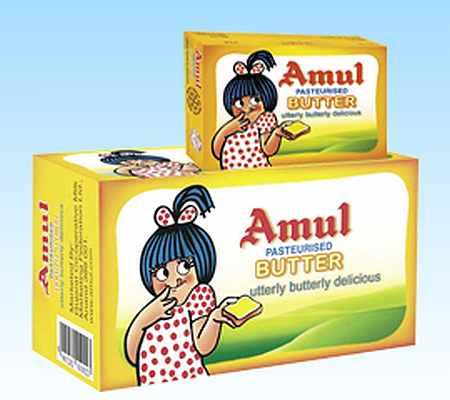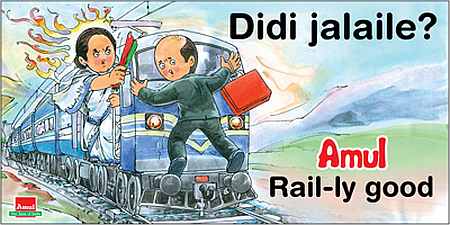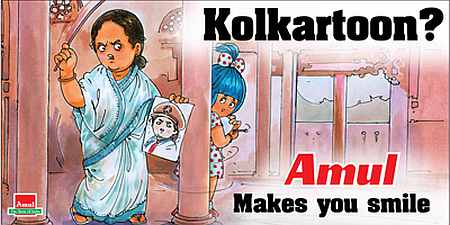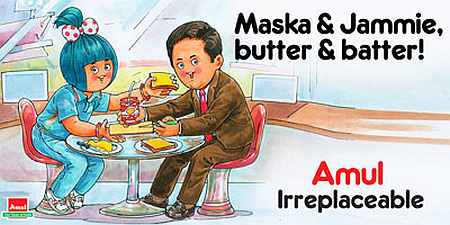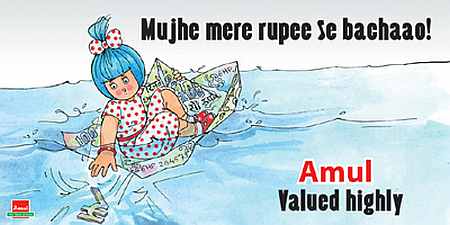 | « Back to article | Print this article |
Amul's Utterly, Butterly girl is still winning hearts at 50
In an India, where cartoons in a school textbook create political furore, a tongue-in-cheek humour brought alive by the mascot of a butter brand has survived -- rather thrived -- for 50 years now.
Yes, the girl in a polka dotted dress, with a matching bow in her hair, for whom no subject is taboo, no individual beyond her jibes, whom we know fondly as the Amul Girl, has just completed half a century peering down billboards.
Amul and its creative partner daCunha Commu-nications have put out close to 6,000 billboards pan-India.
Click NEXT to read more...
Amul's Utterly, Butterly girl is still winning hearts at 50
Starting with product-specific campaigns that were run mostly in print and radio, the first billboard appeared in 1966 - the Amul moppet kneeling in prayer, with one eye closed and another on the pack of butter with the words, "Give us this day our daily bread with Amul Butter."
It drew instantaneous reactions from the public about her 'cuteness' and since then there has been no looking back.
Click NEXT to read more...
Amul's Utterly, Butterly girl is still winning hearts at 50
No offence, none taken
The Amul girl was the result of her co-creator, Sylvester daCunha's vision of a "child, someone impish and lovable" to mouth the line, "utterly butterly delicious (the brand's tagline that was originally objected to on the grounds that 'butterly' was grammatically incorrect).
But this 'child's' ability to so good naturedly rib people and get away with it may not be incidental.
lpana Parida, president, DY Works, a brand solutions firm that has designed a coffee table book to commemorate 50 years of Amul hoardings, says consumer's association with her is at a deeper level.
Click NEXT to read more...
Amul's Utterly, Butterly girl is still winning hearts at 50
She explains the semiotic significance of the moppet: "Amul butter is the product that epitomises the brand. In our mythology, Bal Krishna's love for butter is well known and still celebrated.
Further, Krishna represents the innocent naughtiness every mother wants in her own child. In that context, the Amul girl is Bal Krishna. She is extremely lovable and all her transgressions forgiven."
There is another take on the moppet's continued popularity. Earlier this year, after ex-railway minister, Dinesh Trivedi suffered a severe backlash from his own political party supremo, Mamata Banerjee over increased railway fares.
Click NEXT to read more...
Amul's Utterly, Butterly girl is still winning hearts at 50
Amul, in its characteristic style, almost instantaneously put out a billboard on the issue in Kolkata. There was an uproar about this but it didn't make headlines as did the party's antics over arresting a professor for distributing some 'objectionable' cartoons. Why this variation?
Rahul daCunha, MD and creative head, daCunha Communications attributes it to the regard held by even the polity for the brand.
"Amul is one of the oldest and best known, fully Indian brands and holds a special place in our place. It is also at the end of the day a co-operative. I guess these factors do play a role in influencing the way everyone interacts and views the brand itself," says daCunha.
Click NEXT to read more...
Amul's Utterly, Butterly girl is still winning hearts at 50
That said, he doesn't deny the necessity for being responsible in their communication; to ensure that no party is offended and there is no negative impact on the brand.
That doesn't mean that sensitive topics be avoided but rather strategies be reworked. Case in point: the professor arrest case in Kolkata. A hoarding on the issue was put out, albeit everywhere but in Kolkata.
Click NEXT to read more...
Amul's Utterly, Butterly girl is still winning hearts at 50
Keep them coming
The more things change, the more they stay the same. Amul's hoarding has followed this diktat, continuing to move as India has. While the content continues to be inspired by current affairs, distribution strategies have evolved over the years.
"Few topic are national these days. We have started doing a lot more regional campaigns," says daCunha. Reason: there are four Indias: Mumbai, the Hindi speaking belt (Punjab, Madhya Pradesh, Uttar Pradesh, Bihar etc), East and South India.
"The topics that are relevant in one region may not be applicable in another. For instance, a hoarding pertaining to international politics may not be as relevant in the Hindi speaking belt as in Mumbai."
Click NEXT to read more...
Amul's Utterly, Butterly girl is still winning hearts at 50
Keeping with the times, the hoardings have also gone virtual, some designed specifically for the social media like Facebook.
"The issue of Ashton Kutcher donning a brown face and receiving flak from the non-resident Indian community may be more pertinent for the online audience than the average man on the street. The hoardings thus need to be focused at the right audience," says daCunha.
But that still may not explain the lightning speed with which the hoardings hit the streets.
Click NEXT to read more...
Amul's Utterly, Butterly girl is still winning hearts at 50
Here's a peek into the modus operandi of the making them: Each Monday morning, the creative team meets and lists possible issues that can be spun off into hoardings.
Topics like politics, sports and Bollywood are naturally favourites. A list of 10 topics is drawn up and on an average five are pushed each week. That's an average of a hoarding per day and a half.
The billboards are contracted on an annual basis to facilitate a year-round display, making it possible for even the likes of Rahul Dravid to trek to the same location to catch the latest Amul campaign.
Click NEXT to read more...
Amul's Utterly, Butterly girl is still winning hearts at 50
Technology has also played a key role in ensuring quick reach as the creative can be delivered anytime, anywhere.
Today, the brand that holds over 80 per cent share in the butter market is an enviable position.
It is probably one of the few brands that can boast of a consumer base that cannot get enough of its advertising, wanting more and more.
